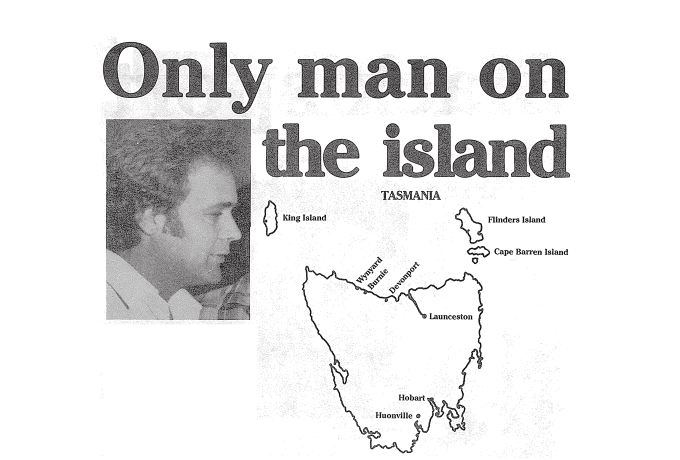
DSS servicing for Aboriginal people expands in Tasmania
It took time and activism to establish government services for Aboriginal people in Tasmania. These DSS newsletters introduce the first Tasmanian Aboriginal Liaison Officer in 1984 and show how services expanded into the 1990s.
... he feels that he is really needed by the Aboriginal community and finds that the work, although demanding, is very rewarding …
| Attachment | Size |
|---|---|
| jumbunna-may-1984-dec-1991.pdf | 2.89 MB |
| Attachment | Size |
|---|---|
| jumbunna-newsletter-articles-plaintext.docx | 690.96 KB |
In the early 1980s, the Department of Social Security (DSS) began to expand specialist servicing for Palawa / Aboriginal people in Tasmania. These articles show how support grew over time. They highlight how Aboriginal DSS staff strengthened services for their communities.
A history of increasing activism in Tasmania
In the 1960s and 1970s Aboriginal people in Lutruwita / Tasmania increasingly agitated for greater control over their affairs and better recognition of their needs.
There were many Palawa families living across Tasmania, including strong communities based on Cape Barren Island to the north-west of the state. People here resisted attempts to be moved away from their lands and maintained their cultural practices and Aboriginal identity.
Tasmanian Aboriginal people’s political claims were strengthened by the calls for Aboriginal self-determination on the Australian mainland from the late 1960s.
In Hobart, the Aboriginal Information Centre was set up in 1972 to represent Aboriginal people. It changed to the Tasmanian Aboriginal Centre in 1977. Tasmanian representatives were elected to the federal government’s National Aboriginal Consultative Committee in 1973.
First Tasmanian Aboriginal Liaison Officer
This excerpt is from a DSS newsletter titled, Jumbunna: Let’s Talk Together. The newsletter was made by and for DSS Aboriginal and Torres Strait Islander staff. It aimed to inform staff about changes and opportunities. It also often included stories about Aboriginal and Torres Strait Islander staff and their achievements.
Jumbunna issues regularly profiled Aboriginal Liaison Officers (ALO) around the country. This article published in May 1984 featured David Mallett, the first ALO in Tasmania.
David Mallett began working as an ALO in Tasmania in 1981. For many years, he was the only ALO working in the entire state. He was based in Launceston and travelled often in the role, maintaining connections with organisations including the Tasmanian Aboriginal Centre.
In the article, Mallett says his work, ‘although demanding, is very rewarding’ and that ‘he feels he is really needed by the Aboriginal community’.
Expansion of DSS Aboriginal services
In 1991, the December Jumbunna issue featured Tasmanian servicing once again.
One article title, ‘Yes, we have an ATSI Services Unit in Tasmania’, suggested that there was a lack of awareness of Tasmanian Aboriginal affairs on the Australian mainland.
The article highlighted that there were now 2 Aboriginal staff members as part of the unit, including ALO Brett Templar.
The article discussed some difficulties of the ALO role. One person trying to meet the needs of thousands of Aboriginal people was not sufficiently ‘increasing access and equity’. Given these challenges, the unit was shifting its focus to work with community groups and organisations to help share information, rather than only talking with individual people.
Leadership of Tasmanian Aboriginal women
The 1991 Jumbunna issue also highlighted Tasmanian Aboriginal women taking on new leadership roles in DSS.
Kate Kelleher was promoted to Regional Manager of the Burnie office, the first Tasmanian Aboriginal woman in this position. Photographed with her was Maggie Walter, who was the Jobs Education and Training (JET) Program advisor.
Aboriginal sole parents’ involvement in the JET program was discussed in a report by Aboriginal and Torres Strait Islander Servicing Unit manager Lorraine Randall. JET was also promoted to Aboriginal women in a video made a few years later. Contact with Aboriginal DSS staff members was considered important for Aboriginal people’s access to services.
Activism and servicing
Palawa / Tasmanian Aboriginal people’s activism was closely linked to improving access to social servicing in the state. Many Aboriginal DSS staff, including Walter, had personal connections to groups like the Tasmanian Aboriginal Centre.
You can read another article from the Jumbunna December 1991 issue.
Permissions
Permission to reproduce the article from 1984 was granted by David Mallett’s daughter Michelle Mallett.
Permissions to reproduce the articles from 1991 were granted by Distinguished Emerita Professor Maggie Walter and Kate Kelleher of the Trawwoolway Clan from Tebrakunna Country, and by Brett Templar of the Trawwoolway and Plangermaireener people.
One person’s name was withheld from the document as they were not able to be consulted with.
The inclusion of Palawa kani, the language of Tasmanian Aborigines, is with thanks to the Tasmanian Aboriginal Centre.
Citation
Department of Social Security (May 1984) ‘Only man on the island’, p 3, Jumbunna: Let’s Talk Together.
Department of Social Security (December 1991) ‘Yes, we have an ATSI Services Unit in Tasmania’, and ‘First Aboriginal women Regional Manager and JET Advisor appointed in Tasmania’, p 8, Jumbunna: Let’s Talk Together.
